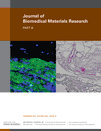Fabrication of electrospun silica–titania nanofibers with different silica content and evaluation of the morphology and osteoinductive properties†
How to cite this article: Wang X, Zhu J, Yin L, Liu S, Zhang X, Ao Y, Chen H. 2012. Fabrication of electrospun silica–titania nanofibers with different silica content and evaluation of the morphology and osteoinductive properties. J Biomed Mater Res Part A 2012:100A:3511–3517.
Abstract
Ceramic-derived materials have shown enhanced osteogenic potential for bone tissue engineering applications. Silica is the major component of bioglass, and titania, the oxide complex of titanium, has been found to enhance osteoblast differentiation. In this study, three groups of sol–gel-derived silica–titania fibrous meshes with precursor ratios of Ti:Si = 7:3, 1:1, 3:7 were fabricated by electrospinning. The effects of silica content on the crystal phase and morphology of silica–titania hybrid nanofiber meshes were also analyzed by scanning electron microscopy, X-ray diffraction, and laser confocal microscopy. The osteogenic potential of the silica–titania meshes was evaluated by seeding mesenchymal stem cells (MSCs) on each mesh and determining cell number, osteodifferentiation markers, and osteopontin production over time. Our results show that cells proliferated throughout the mesh surfaces with similar morphology in all groups. Decreased cell proliferation was observed with the fiber meshes compared with glass controls, whereas cell differentiation toward osteoblast was enhanced on the mesh groups, especially on the Ti:Si = 7:3 group. These findings suggest that higher fiber diameter, degree of crystallization, and titania content of nanofibers can enhance osteodifferentiation of MSCs. © 2012 Wiley Periodicals, Inc. J Biomed Mater Res Part A: 100A:3511–3517, 2012.




